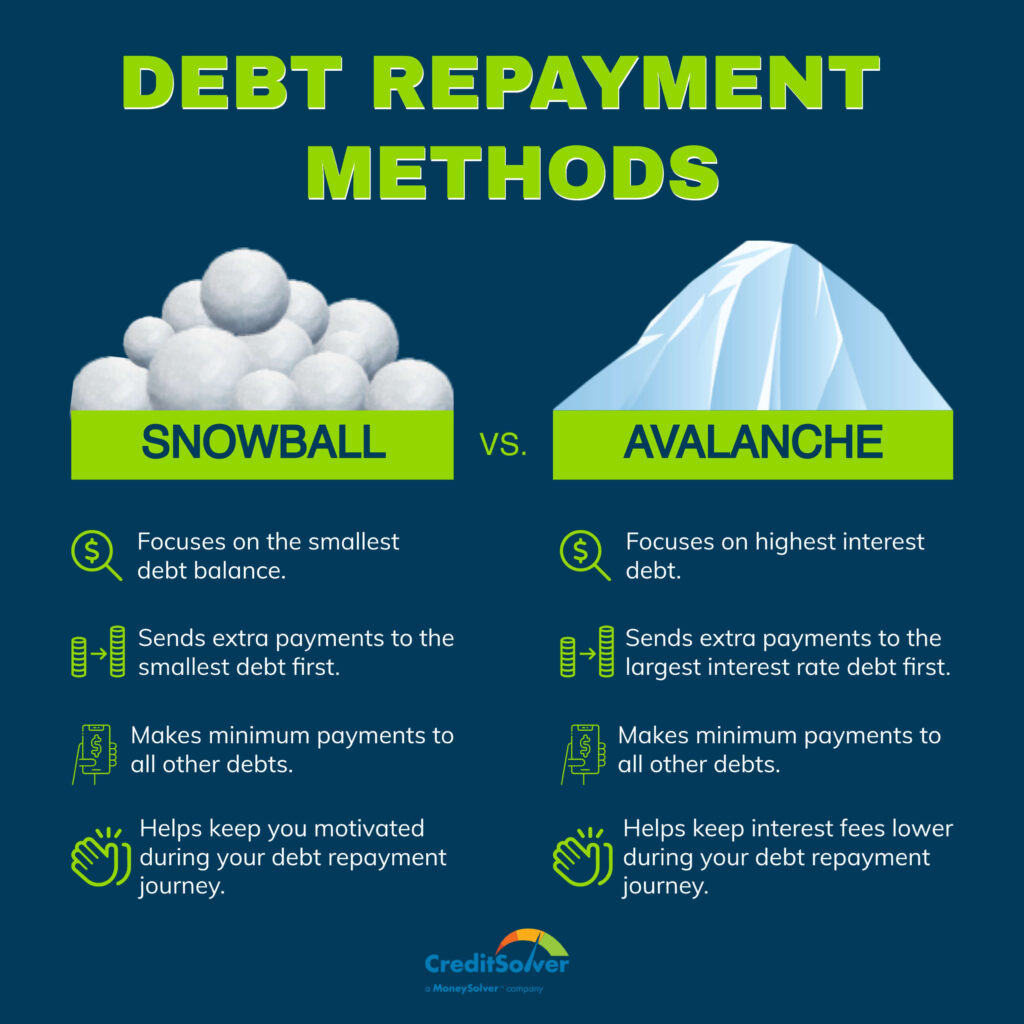Debt Snowball vs. Debt Avalanche: Choosing the Right Debt Repayment Strategy
Managing debt can be a daunting task, but understanding the different debt repayment strategies available can help you make an informed decision on which method is best for you. The two most popular strategies for paying off debt are the debt snowball and debt avalanche methods. To learn how each works, the main differences between them, and which repayment strategy is best for you, keep reading.
Debt Repayment Strategies: Debt Snowball vs. Debt Avalanche
Debt repayment strategies can help you pay off your debts faster and more efficiently. Generally, strategies focus on prioritizing specific debts and allocating extra payments towards them, while still maintaining minimum payments on other debts. By following a structured plan, you can effectively reduce your overall debt and improve your financial well-being.
The Debt Snowball Method
The debt snowball method is a popular debt repayment strategy that focuses on paying off the smallest debts first. By tackling the smallest debts quickly, you can feel a sense of accomplishment and motivation to continue with your debt repayment journey.
The debt snowball method works by listing all outstanding debts in ascending order of the balance owed. Next, focus on paying off the smallest debt first, while still making minimum payments on all other debts. Once the smallest debt is eliminated, the amount previously allocated to that debt is then applied to the next smallest debt, creating a “snowball effect” where the payment amounts increase as each debt is paid off.
Pros of the Debt Snowball Method
The main advantage of the debt snowball method lies in its psychological benefits. By paying off smaller debts quickly, you can experience a sense of accomplishment. This can be especially helpful if you struggle with maintaining the discipline required for a long-term debt repayment strategy.
Cons of the Debt Snowball Method
The primary downside of the debt snowball method is that it may not be the most cost-effective approach. By focusing on the smallest debts first, you may still be accruing a significant amount of interest on larger, high-interest debts.
The Debt Avalanche Method
The debt avalanche method, on the other hand, prioritizes paying off the debts with the highest interest rates first. This strategy can save you more money in the long run, as it aims to minimize the amount of interest paid over time.
This method works by listing all outstanding debts in descending order of the interest rate. Then, focus on paying off the debt with the highest interest rate first, while still making minimum payments on all other debts. Once the debt with the highest interest rate is eliminated, the amount previously allocated to that debt is then applied to the next highest-interest debt. Ultimately, this reduces the total interest paid over time.
Pros of the Debt Avalanche Method
The primary advantage of the debt avalanche method is its potential for significant interest savings. By prioritizing high-interest debts, you can minimize the overall interest paid and potentially pay off your debts more quickly.
Cons of the Debt Avalanche Method
The downside of the debt avalanche method is that it may not provide the same emotional benefits as the debt snowball method. Paying off high-interest debts may take longer, which can be discouraging and potentially lead to a loss of motivation.
Debt Snowball or Debt Avalanche? What to Consider
When choosing between the debt snowball and debt avalanche methods, it’s essential to consider both the financial and psychological factors involved. While the debt avalanche method may save more money in interest payments, the debt snowball method can provide a motivational boost that helps maintain your commitment to the debt repayment plan.

Financial Factors
From a purely financial perspective, the debt avalanche method is typically the more cost-effective option. By focusing on high-interest debts first, you can reduce the total amount of interest paid and potentially pay off your debts faster. This advantage may be diminished, however, if you struggle to maintain motivation and commitment to the debt repayment plan.
Psychological Factors
For many individuals, the psychological benefits of the snowball method may outweigh the potential interest savings of the avalanche method. By seeing progress quickly through the elimination of smaller debts, you may be more motivated to continue with your debt repayment plan and ultimately achieve your financial goals.
Which Method is Best for Restoring Credit Rating?
When determining which method is best for quickly restoring your credit rating, it’s important to understand that both the debt snowball and debt avalanche methods can contribute to credit score improvement. By reducing overall debt and consistently making on-time payments, you can demonstrate responsible credit management and improve your credit scores over time.
It’s worth noting, however, that the debt avalanche method may have a slightly stronger impact on credit score improvement, as it directly addresses high-interest debts that can have a more significant impact on credit utilization ratios. By reducing high-interest debts, you can lower your credit utilization and potentially see more substantial improvements in your credit scores.
Final Thoughts
Ultimately, the decision between the debt snowball and debt avalanche methods will depend on your individual preferences, financial circumstances, and personal motivation. It’s essential to carefully consider the benefits and drawbacks of each and choose the strategy that best aligns with your financial goals and personality.
By committing to a debt repayment strategy and maintaining discipline in managing personal finances, you can successfully reduce your debt, improve your credit rating, and achieve financial stability.


